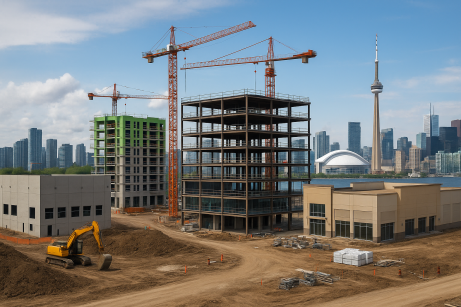
As we move through 2025, Ontario’s commercial real estate (CRE) sector is navigating a period of recalibration. While market headwinds remain—ranging from economic uncertainty to shifts in how and where people work—there are signs of resilience and renewal across the province's key asset classes. Investors, developers, and tenants alike are adjusting their strategies, creating a more nuanced and opportunity-driven market.
🏢 Office Space: Redefining Use and Demand
Ontario’s office market continues to evolve in response to long-term changes in workplace behavior. Hybrid and remote work setups have led to a slowdown in traditional leasing activity, especially in downtown cores. In the Greater Toronto Area (GTA), vacancy rates remain elevated for older office buildings, while newer, amenity-rich properties in prime locations are attracting steady interest.
Beyond leasing trends, adaptive reuse is becoming more common. Office-to-residential conversions are gaining momentum, particularly in cities like Kitchener-Waterloo, as developers look to repurpose underutilized space to address housing shortages.
🏭 Industrial Real Estate: Cooling After a Surge
Ontario’s industrial market, long considered one of the most resilient real estate segments, is experiencing a slight slowdown. After years of record-low vacancies and skyrocketing rents, availability is starting to rise—particularly in large urban markets like the GTA.
Rental rates are beginning to stabilize, yet demand remains strong in key submarkets such as Vaughan, Mississauga, and Brampton. Specialized industrial spaces, including cold storage and data centers, are also attracting increasing attention as e-commerce, logistics, and digital infrastructure continue to evolve.
🏬 Retail Sector: Leaning Into Local and Essential
Despite a 2024 dip in overall investment volume, the retail landscape in Ontario is holding steady through strategic reinvention. Essential-service retailers, grocery-anchored plazas, and smaller-format stores are outperforming traditional big-box and mall setups.
Retail development remains limited due to high construction costs, placing upward pressure on rents in high-demand areas. The strongest-performing retail assets are those that align with changing consumer habits—offering convenience, value, and community-centric service.
📈 Market Outlook: Cautious Optimism in 2025
Looking ahead, Ontario’s commercial real estate market is expected to gain momentum as interest rates begin to stabilize and confidence returns to capital markets. Investors are taking a more strategic, selective approach—focusing on properties with strong fundamentals and long-term growth potential.
As we progress through the year, those able to adapt to changing conditions—whether through property repositioning, flexible leasing, or niche investments—are likely to benefit most from the opportunities that arise.
Ontario’s CRE sector is no longer in boom mode, but it’s far from stagnant. This is a market in transition—one that rewards patience, innovation, and strategic thinking. Whether you’re an investor, developer, or tenant, 2025 is shaping up to be a year of thoughtful moves and long-term plays in commercial real estate.